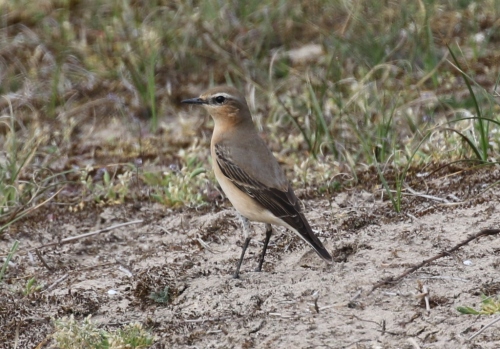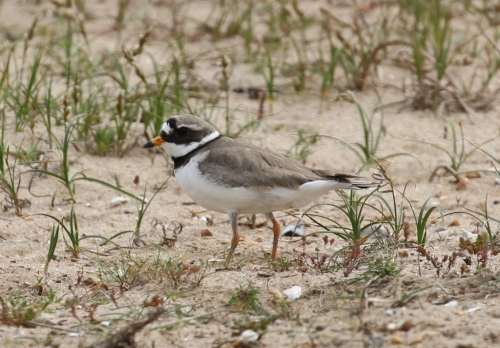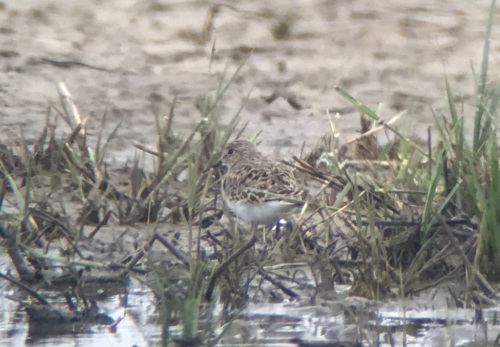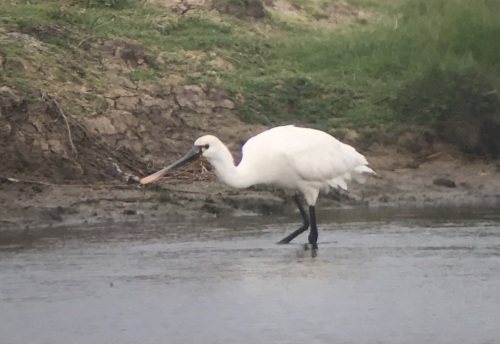Saturday 12th May 2018
Burnham Overy then Cley/Salthouse
Highlights:
Swifts everywhere now 30+
Peregrine 100 metres from my digs - on ledge near the top of local church
Swifts everywhere now 30+
Peregrine 100 metres from my digs - on ledge near the top of local church
Hobby x2
Little Tern x30
Spoonbill
Temminck's Stint
Marcus' report is shown below:






12th May 2018 – Norfolk in May, Day 2
Day 2 of a three day long weekend of tours today, back in Norfolk. It was a lovely bright, sunny and pleasantly warm morning, but it clouded over early afternoon and then started to spit with rain on and off later on. Nothing to stop us getting out and about though!
Driving down to pick everyone up for the day, we spotted a Peregrine out of the corner of an eye, flying up to land on a church tower. We couldn’t stop, but when we had collected the rest of the group, we headed back and thankfully it was still there. It stared down at us at first, as we got out of the car and we stared back up at it. It quickly settled down and seemed completely unconcerned by our presence below.

Peregrine – great views perched and then preening on the church tower this morning
We watched the Peregrine for some time. It perched looking round at first, then started to preen. When it had finished, it began to doze, closing one eye but still looking round with the other. Several Common Swifts were screaming round over the rooftops as we stood there, always a great sight and sound, although they rather played second fiddle to the Peregrine.
Eventually we managed to tear ourselves away and headed over to Burnham Overy Dunes for the morning. As we walked down across the path over the grazing marshes we could hear Common Whitethroat and Lesser Whitethroat singing in the hedges. The former perched up nicely and we saw the latter flitting around in the foliage.
Several Sedge Warblers were singing from the bushes all the way out and there are lots of Reed Warblers in too now. We could hear them singing from the reeds along the edge of the ditches by the path and eventually got good views of one or two at the far end.

Reed Warbler – one or two showed themselves on the walk out this morning
There were Lapwings, Avocets, Oystercatchers and Redshanks all out on the grazing marshes by the path. A Lapwing put on a nice tumbling display for us and some of the others appeared to be on nests.
There was no shortage of Greylags here and a pair of Egyptian Geese out on the grass too. We added a few ducks to the day’s list, with Shoveler and Gadwall around the small pools. In the channel at the far end of the path, we stopped to admire a smart Little Grebe on the edge of the reeds. A couple of Common Pochard were on the water further back.
Up on the seawall, the tide was out and there were lots of waders down on the mud. There was a large group of Black-tailed Godwits, with one or two in full summer plumage, deep orange on head and neck. A small group of Knot were with them and they too were mostly in bright rusty breeding plumage. Further over, we could see several Grey Plover looking very smart in breeding plumage too, with black faces and bellies.
A lone Wigeon was out on the reedbed pool, a nice addition to the weekend’s list, as the vast majority have already headed off back to Russia for the breeding season. Further along, out on the saltmarsh, we could see a sizeable gaggle of Brent Geese still. Some of these are always later to head back to the Arctic, although the majority will have departed by the end of this month.
A small group of waders whirled round over the grazing marsh and landed out on an island in one of the smalls. Through the scope, we could see there was a nice mixture of Ringed Plovers and Dunlin, and several of the latter were in breeding plumage, sporting contrasting black belly patches.
Out into the dunes, we turned east. We walked out to one of the favourite places for Wheatears, and quickly found one, a female, down on the short grass. Two more were Wheatears high in the dunes above – what looked like a male and another female. We walked round for better look, trying to get the sun behind us, but could only see the two females now. Big and deep orange underneath, they appeared to be Greenland Wheatears, of the subpecies leucorhoa.

Wheatear – a female, presumably of the Greenland race
Heading back to the boardwalk, we continued on out towards Gun Hill. A trickle of hirundines were moving west now, mostly Swallows, but with a few House Martins and a single Sand Martin as well. A sharp call alerted us to a Yellow Wagtail which flew over our heads and continued on west too.
There is no shortage of Meadow Pipits and Linnets out here in the dunes, good to see as both species have declined so markedly in farmland. A male Kestrel perched high in one of the taller dunes. We also found several male Stonechats singing, 2 or 3 on our walk west.
Heading out onto the beach, we stopped to admire a Ringed Plover tucked down in the stones, on its nest out in the middle of the fenced off area. Another Ringed Plover ran in over the stones and we watched as they changed over sitting duty.
We could hear Little Terns but there were none at the top of the beach in the fenced off area. They were all out towards the shore – we could see them flying round, diving into the surf out at the mouth of the channel. One was asleep closer to us, on the sand just across the channel, which we got in the scope and three more flew round over our heads calling, one carrying a fish. There were a couple of Common Terns too, further round, plunge diving in the harbour channel.

Ringed Plover – we saw several on the beach and around the dunes today
As we walked along beach towards the point, we found more waders. A couple of very smart Turnstones in breeding plumage were feeding in and out of the seaweed covered rocks below us. Two Common Sandpipers flew up from the edge of the water and across the channel calling. There were several more Ringed Plovers too and round in the harbour we found three Bar-tailed Godwits with another Grey Plover out on the mud. A Greenshank flew up calling from the saltmarsh briefly but dropped straight back down into one of the muddy creeks, out of view.
Back at the boardwalk, we made our way back along the seawall. At the reedbed, a Bittern boomed three times in quick succession before going quiet again. A Red Kite was hanging lazily in the air over the fields as we got back to the car.
We had our lunch at Holkham and afterwards, we headed back east. We had been to Cley yesterday and were not intending to go back today, but news of a Temminck’s Stint was too good to resist.
The Temminck’s Stint had been mobile earlier, but then seemed to have settled down on Watling Water. However, when we arrived at Iron Road, we were told it had flown off about half an hour earlier. It had apparently appeared to drop down again towards the pools along the track. We had a good look there, but there was no sign of it, although there were two Ringed Plovers and a Little Ringed Plover.
Other waders were clearly on the move today, as another small mixed flock of Dunlin and Ringed Plovers dropped in briefly before continuing west. Another Wheatear was on the bank on the far side of the pool and a Hobby flew over, heading off east. It had started to drizzle now, on and off, we so headed round to Babcock Hide on the off chance that the Temminck’s Stint was back.
When we got into the hide, we were delighted to find that the Temminck’s Stint was indeed back out on the mud, having apparently flown back in earlier. We got it in the scope and had great views of it creeping around on the mud around the edge of the pool. It was clearly very small, and we could see its yellow legs and the distinctive scattering of black-centred feathers in its upperparts.

Temminck’s Stint – a well-marked individual on Watling Water
The two Little Ringed Plovers we had seen yesterday were still on the scrape too – and as we had seen with the Common Sandpiper they kept trying to chase the Temminck’s Stint off. Eventually it found a spot where they seemed to lose interest, and stopped to bathe. The Common Sandpiper was still on here too, but had evaded the attention of the plovers as they seemed to focus more on chasing off the stint today!
The rain had now eased off again, and there was still time for a walk out on the East Bank before the end of the day. It didn’t take us long to spot the Spoonbill, a large white shape in the distance, so we headed up along the bank for a closer look. On the way, a scan of Pope’s Pool produced another Common Sandpiper and a Little Ringed Plover, as well as another lone drake Wigeon, our second of the day. A Marsh Harrier was perched up in one of the bushes out in the reedbed, drying out after the rain.
We had good views of the Spoonbill from here. It was busy feeding in the north end of the Serpentine, head down, sweeping its bill quickly left to right through the water. Occasionally it would flick its head up when it caught something.

Spoonbill – feeding out on the Serpentine
Arnold’s Marsh appears to be drying out rapidly at the moment, and there was not much water left. Still, we found a few waders – a couple of Bar-tailed Godwits, a Curlew, a Grey Plover and a Ringed Plover. A Wheatear on one of the posts out in front of the shingle ridge was a male Greenland Wheatear, deep orange breasted and with brown tones in its grey back. At the far end of Arnold’s, a Hobby was perched preening on a post.
It was time to head back now. A Marsh Harrier dropped down towards the grazing marsh below the bank, mobbed by Avocets, and then flew off, carrying what appeared to be a small mammal rather than one of the young Greylags we had seen there on our walk out. A Hobby flew past and off over the reedbed, possibly the one we had seen on the post earlier, now dried out. Several more Marsh Harriers were up circling over the reeds as we headed for home.
No comments:
Post a Comment
Note: only a member of this blog may post a comment.